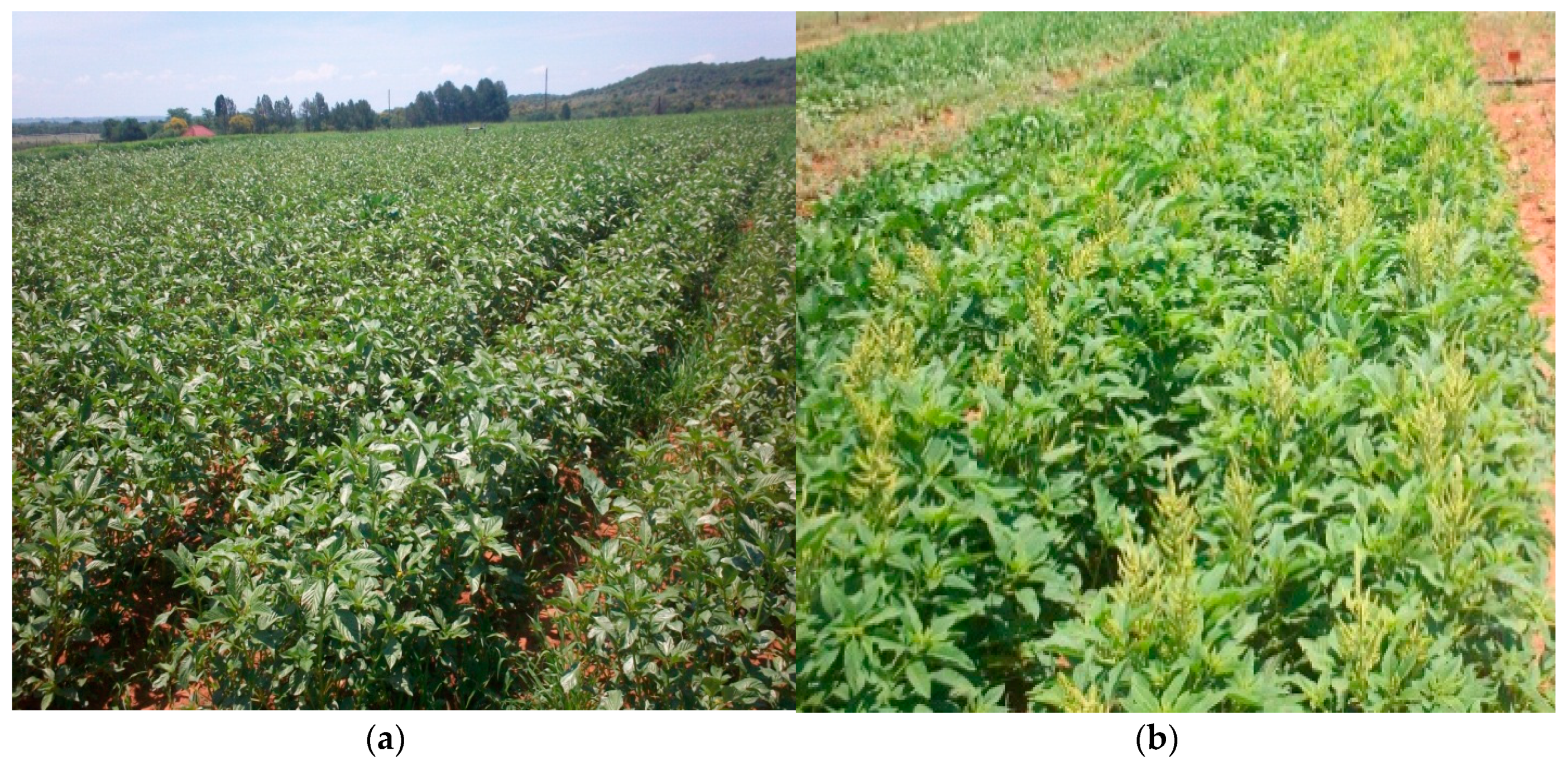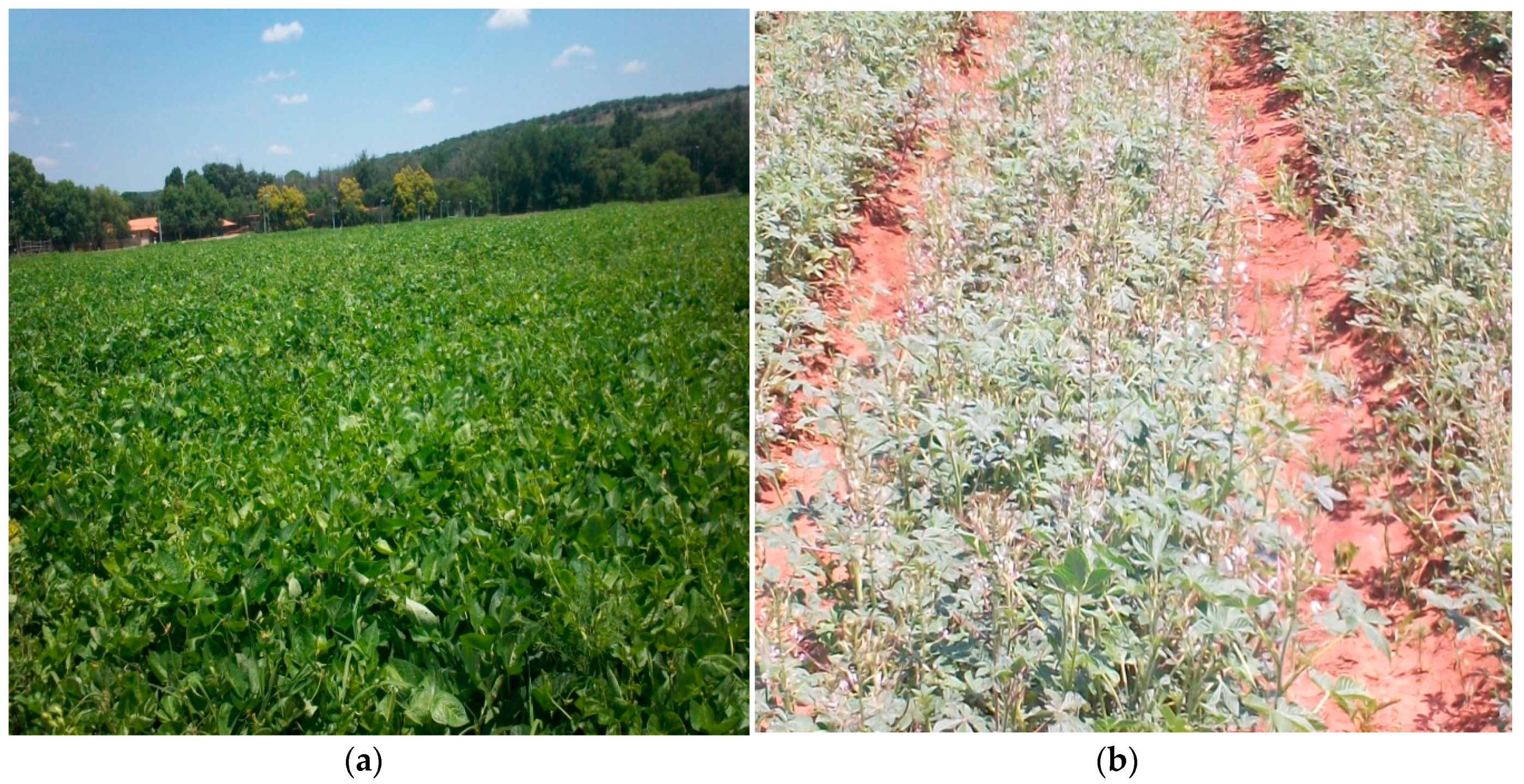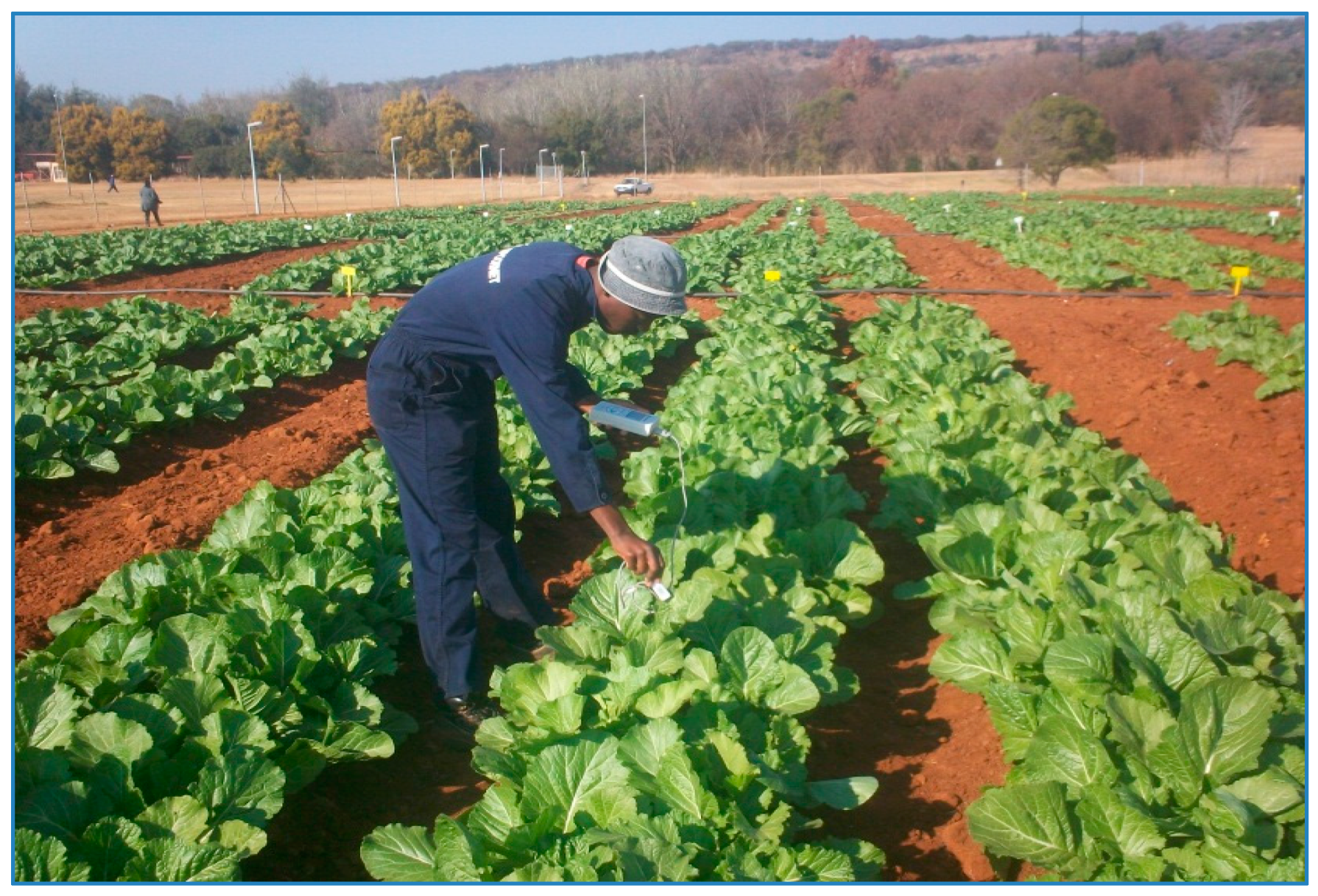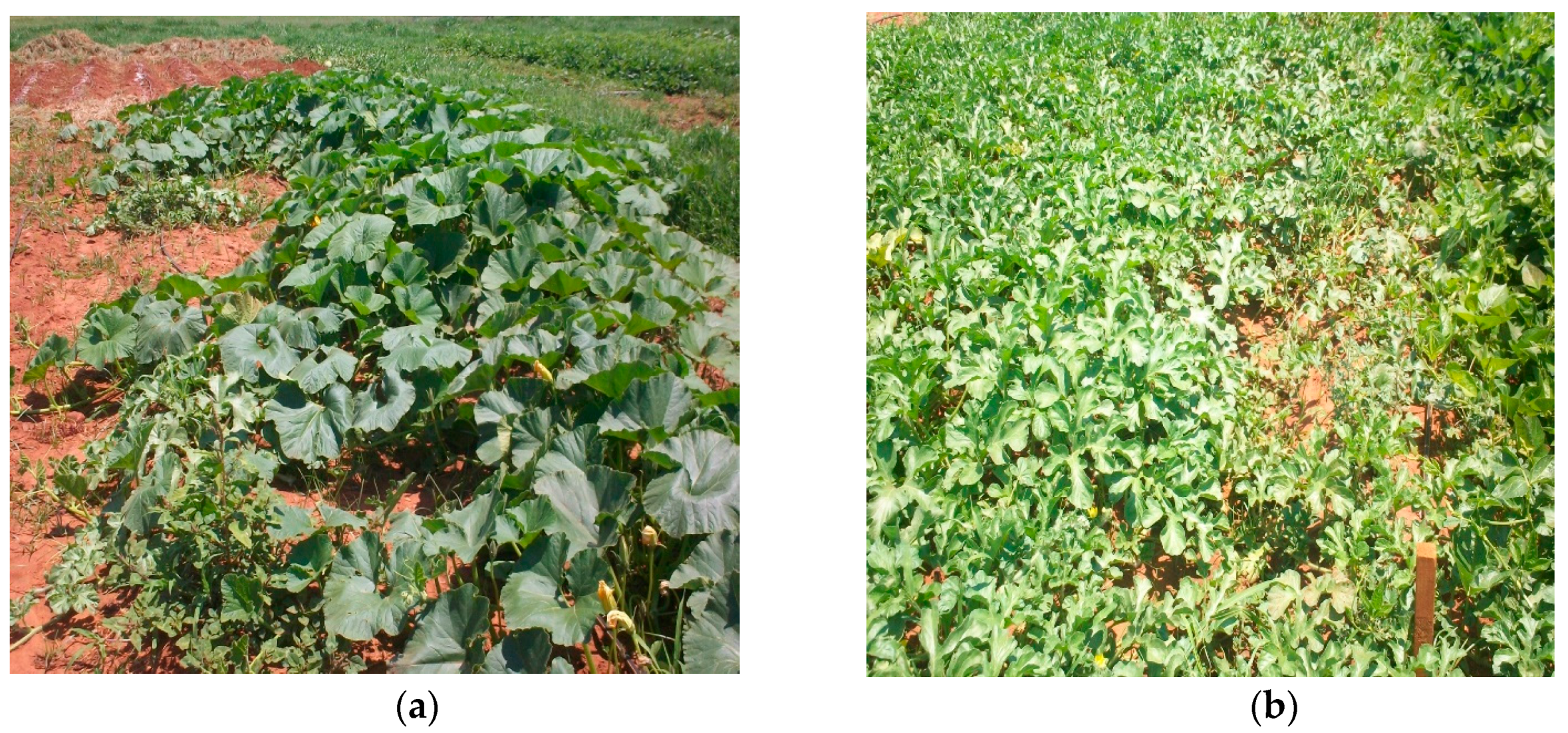African Leafy Vegetables: A Review of Status, Production and Utilization in South Africa
Abstract
:1. Introduction
- (1)
- What is the status of production and utilisation of ALVs in South Africa?
- (2)
- What can be done to promote production and utilisation of ALVs in South Africa?
- (3)
- What are potential gaps and research priorities for future research of ALVs in South Africa?
Methods Used for Literature Search
2. Current Status of Utilisation and Production of Leafy Vegetables
2.1. Diversity of ALVs
2.2. Utilisation
2.3. Production
2.4. Marketing of Leafy Vegetables in South Africa
2.5. The Role of the Private and Public Sector in Promoting ALVs
3. Nutritional Value
4. Drought Tolerance and Resilience
5. Water Use of ALVs
6. Post-Harvest Handling and Storage of ALVs
6.1. Cooling and Storage
6.2. Packaging
6.3. Drying
6.4. Cooking
7. Conclusions
Acknowledgments
Author Contributions
Conflicts of Interest
References
- Van Rensburg, W.S.J.; Van Averbeke, W.; Slabbert, R.; Faber, M.; Van Jaarsveld, P.; Van Heerden, I.; Wenhold, F.; Oelofse, A. African leafy vegetables in South Africa. Water SA 2007, 33, 317–326. [Google Scholar] [CrossRef]
- Nesamvuni, C.; Steyn, N.P.; Potgieter, M.J. Nutritional value of wild, leafy vegetables consumed by the Vhavhenda. S. Afr. J. Sci. 2001, 97, 51–54. [Google Scholar]
- Odhav, B.; Beekrum, S.; Akula, U.; Baijnath, H. Preliminary assessment of nutritional value of traditional leafy vegetables in KwaZulu-Natal, South Africa. J. Food Comp. Anal. 2007, 20, 430–435. [Google Scholar] [CrossRef]
- Vorster, I.H.J.; Stevens, J.B.; Steyn, G.J. Production systems of traditional leafy vegetables, Challenges for research and extension. S. Afr. J. Agric. Ext. 2008, 37, 85–96. [Google Scholar]
- Maunder, E.M.W.; Meaker, J.L. The current and potential contribution of home-grown vegetables to diets in South Africa. Water SA 2007, 33, 401–406. [Google Scholar] [CrossRef]
- Oelofse, A.; van Averbeke, W. Nutritional Value and Water Use of African Leafy Vegetables for Improved Livelihoods; WRC TT535/12; Water Research Commission: Pretoria, South Africa, 2012. [Google Scholar]
- Abukutsa-Onyango, M.O. Unexploited Potential of Indigenous African Vegetables in Western Kenya. Department of Botany and Horticulture. Maseno J. Educ. Arts Sci. 2003, 4, 103–122. [Google Scholar]
- Van Averbeke, W.; Chabalala, M.P.; Okorogbona, A.O.M.; Rumania, T.D.; Azeez, J.O.; Slabbert, M.M. Plant nutrient requirements of African leafy vegetables. In Nutritional Value and Water Use of African Leafy Vegetables for Improved Livelihoods; WRC TT535/12; Oelofse, A., Van Averbeke, W., Eds.; Water Research Commission: Pretoria, South Africa, 2012. [Google Scholar]
- Department of Agriculture, Fisheries and Forestry, Strategic Plan for the Department of Agriculture. Consolidting the Partnership for Poverty Eradication, Accelerated Growth and Wealth Creation; Directorate Agricultural Information Services: Pretoria, South Africa, 2004. [Google Scholar]
- Van Rensburg, J.W.S.; Venter, S.L.; Netshiluvhu, T.R.; Van Den Heever, E.; Vorster, H.J.; De Ronde, J.A. The role of indigenous leafy vegetables in combating hunger and malnutrition. S. Afr. J. Bot. 2004, 70, 52–59. [Google Scholar] [CrossRef]
- Shiundu, K.M.; Oniang’o, R. Marketing African leafy vegetables, challenges and opportunities in the Kenyan context. Afr. J. Food Agric. Nutr. Dev. 2007, 17, 4–12. [Google Scholar]
- Mabhaudhi, T.; Modi, A.T.; Beletse, Y.G. Response of taro (Colocasia. esculenta L. Schott) landraces to varying water regimes under a rainshelter. Agric. Water Manag. 2013, 121, 102–112. [Google Scholar]
- Mabhaudhi, T.; O’Reilly, P.; Walker, S. The role of underutilised crops in Southern African farming systems, a scoping study. Sustainability 2016, 8, 302. [Google Scholar] [CrossRef]
- Mavengahama, S. The Contribution of Indigenous Vegetables to Food Security and Nutrition within Selected Sites in South Africa. Ph.D. Thesis, Stellenbosch University, Cape Town, South Africa, 2013. [Google Scholar]
- Van Wyk, B.E. Food Plants of the World, Identification, Culinary Uses and Nutritional Value, 1st ed.; Briza Publication: Pretoria, South Africa, 2005. [Google Scholar]
- Steyn, N.P.; Olivier, J.; Winter, P.; Burger, S.; Nesamvuni, C. A survey of wild, green leafy vegetables and their potential in combating micronutrient deficiencies in rural populations. S. Afr. J. Sci. 2001, 97, 276–278. [Google Scholar]
- Shackleton, C.M. The prevalence of use and value of wild edible herbs in South Africa. S. Afr. J. Sci. 2003, 99, 23–25. [Google Scholar]
- Venter, S.L.; van Rensburg, W.S.J.; Vorster, H.J.; van den Heever, E.; van Zijl, J.J.B. Promotion of African Leafy Vegetables within the Agricultural Research Council—Vegetable and Ornamental Plant Institute, The impact of the project. Afr. J. Food Agric. Nutr. Dev. 2007, 7, 1–7. [Google Scholar]
- Vorster, H.J.; Van Rensburg, W.J.; Venter, S.L.; Van Zijl, J.J.B. (Re)-creating awareness of traditional leafy vegetables in communities. In Proceedings of the Regional Workshop on African Leafy Vegetables for Improved Nutrition, IPGRI, Nairobi, Kenya, 6–9 December 2005. [Google Scholar]
- Vorster, H.J.; van Rensburg, W.S.J.; Van Zijl, J.J.B.; Van den Heever, E. Germplasm Management of African Leafy Vegetables for the Nutritional and Food Security Needs of Vulnerable Groups in South Africa; ARC-VOPI: Pretoria, South Africa, 2002. [Google Scholar]
- Modi, M.; Modi, A.T.; Hendriks, S. Potential role for wild vegetables in household food security, A preliminary case study in KwaZulu-Natal, South Africa. Afr. J. Food. Agric. Nutr. Dev. 2006, 6. [Google Scholar] [CrossRef]
- Matenge, S.T.P.; van der Merwe, D.; De Beer, H.; Bosman, M.J.C.; Kruger, A. Consumers’ beliefs on indigenous and traditional foods and acceptance of products made with cow pea leaves. Afr. J. Agric. Res. 2012, 7, 2243–2254. [Google Scholar]
- Taleni, V.; Goduka, N. Perceptions and Use of Indigenous Leafy Vegetables (ILVs) for Nutritional Value: A Case Study in Mantusini Community, Eastern Cape Province, South Africa. In Proceedings of the International Conference on Food and Agricultural Sciences, Melakaelaka, Malaysia, 5 October 2013. [Google Scholar]
- Maseko, I. Effect of Agronomic Management on Growth and Yield of Selected Leafy Vegetables. Master’s Thesis, University of South Africa, Pretoria, South Africa, 2014. [Google Scholar]
- Silwana, T. The Performance of Maize/Bean and Maize/Pump-Kin Intercrops under Different Planting Combinations and Weeding in Transkei, South Africa. Master’s Thesis, University of Fort Hare, Alice, South Africa, 2000. [Google Scholar]
- Schippers, R.R. African Indigenous Vegetables. In An Overview of the Cultivated Species; Natural Resources Institute/ACP-EU Technical Centre for Agricultural and Rural Cooperation: Chatham, UK, 2000. [Google Scholar]
- Van Averbeke, W.; Juma, K.A.; Tshikalange, T.E. The commodity systems of Brassica rapa L. subsp. chinensis and Solanum retroflexum Dun. In Vhembe, Limpopo Province, South Africa. Water SA 2007, 33, 349–353. [Google Scholar]
- Lewu, F.B.; Adeboola, P.O.; Afolayan, A.J. Commercial harvesting of Pelargonium sidoides in the Eastern Cape, South Africa, Striking a balance between resource conservation and rural livelihoods. J. Arid Environ. 2007, 70, 380–388. [Google Scholar] [CrossRef]
- Mavengahama, S.; McLachlan, M.; de Clercq, W. The role of wild vegetable species in household food security in maize based subsistence cropping systems. Food Secur. 2013, 5, 103–122. [Google Scholar] [CrossRef]
- Van Averbeke, W.; Juma, K.A.; Tshikalange, T.E. Yield response of African leafy vegetables to nitrogen, phosphorus and potassium: The case of (Brassica rapa L. subsp. Chinensis) and (Solanum. retroflexum Dun.). Water SA 2007, 33, 355–362. [Google Scholar]
- Maseko, I.; Beletse, Y.G.; Nogemane, N.; du Plooy, C.P.; Musimwa, T.R.; Mabhaudhi, T. Productivity of non-heading Chinese cabbage (Brassica rapa subsp. chinensis) under different agronomic management factors. S. Afr. J. Plant Soil 2017. [Google Scholar] [CrossRef]
- Mhlontlo, S.; Muchaonyarwa, P.; Menken, P.N.S. Effects of sheep kraal manure on growth, dry matter yield and leaf nutritional composition of a local Amaranthus accession in the central region of Eastern Cape Province, South Africa. Water SA 2007, 33, 363–368. [Google Scholar]
- Motsa, M.M.; Slabbert, M.M.; van Averbeke, W. Germination of leafy vegetables. In Nutritional Value and Water Use of African Leafy Vegetables for Improved Livelihoods; WRC TT535/12; Oelofse, A., Van Averbeke, W., Eds.; Water Research Commission: Pretoria, South Africa, 2012. [Google Scholar]
- Van Averbeke, W.; Netshithuthuni, C. Effect of irrigation scheduling on leaf yield of non-heading Chinese cabbage (Brassica rapa L. subsp. chinensis). S. Afr. J. Plant Soil 2010, 27, 322–327. [Google Scholar] [CrossRef]
- Beletse, Y.G.; du Plooy, C.P.; van Rensburg, J.W.S. Water requirement of eight indigenous vegetables. In Nutritional Value and Water Use of African Leafy Vegetables for Improved Livelihoods; WRC TT535/12; Oelofse, A., Van Averbeke, W., Eds.; Water Research Commission: Pretoria, South Africa, 2012. [Google Scholar]
- Mulandana, N.S.; Mamadi, N.E.; Du Plooy, C.P.; Beletse, Y.G. Effect of spacing and transplanting time on amaranths yield. Afr. Crop Sci. Conf. Proc. 2009, 9, 243–246. [Google Scholar]
- Tesfay, Z.S.; Mathe, S.; Modi, A.T.; Mabhaudhi, T. A Comparative Study on Antioxidant Potential of Selected African and Exotic Leafy Vegetables. Hortscience 2016, 51, 1529–1536. [Google Scholar] [CrossRef]
- Manyelo, K.W.; van Averbeke, W.; Hebinck, P. Smallholder irrigators and fresh produce street traders in Thohoyandou, Limpopo province, South Africa. In Rural Development and the Construction of New Markets; Hebinck, P., van der Ploeg, J.-D., Schneider, S., Eds.; Routledge: London, UK, 2015; pp. 131–148. [Google Scholar]
- Weinberger, K.; Pichop, G.N. Marketing of African vegetables along urban and peri urban supply chain in sub Saharan Africa. In African Indigenous Vegetables in Urban Agriculture; Schackelton, C.M., Pasquiini, M.W., Drescher, A.W., Eds.; Earthscan: London, UK, 2009; p. 298. [Google Scholar]
- Wenhold, F.; Annandale, J.; Faber, M.; Hart, T. Water Use and Nutrient Content of Crop and Animal Food Products for Improved Household Food Security; A Scoping Study; Water Research Commission: Pretoria, South Africa, 2012. [Google Scholar]
- Faber, M.; Phungula, M.A.S.; Venter, S.L.; Dhanat, M.A.; Benade, A.J.S. Home gardens focusing on the production of yellow and dark green leafy vegetables increase the serum retinol concentrations of 2–5-year-old children in South Africa. Am. J. Clin. Nutr. 2002, 76, 1048–1054. [Google Scholar] [PubMed]
- Smith, I.F.; Eyzaguirre, P. African leafy vegetables: Their role in the World Health Organization’s global fruit and vegetables initiative. Plant Food 2007, 7, 3–5. [Google Scholar]
- Afolayan, A.J.; Jimoh, F.O. Nutritional quality of some wild leafy vegetables in South Africa. Int. J. Food Sci. Nutr. 2009, 60, 424–431. [Google Scholar] [CrossRef] [PubMed]
- Manach, C.; Mazur, A.; Scalbert, A. Polyphenols and prevention of cardiovascular diseases. Curr. Opin. Lipidol. 2005, 16, 77–84. [Google Scholar] [CrossRef] [PubMed]
- Amic, D.; Davidovic-Amic, D.; Beslo, D.; Trinajstic, N. Structure-radical scavenging activity relationship of flavonoids. Croat. Chem. Acta 2003, 76, 55–61. [Google Scholar]
- Zobolo, A.M.; Mkabela, Q.N.; Mtetwa, D.K. Enhancing the status of indigenous vegetables through the use of kraal manure substitutes and intercropping. Indilinga Afr. J. Indig. Knowl. Syst. 2008, 7, 211–222. [Google Scholar] [CrossRef]
- Van der Walt, A.M.; Loots, D.T.; Ibrahim, M.I.M.; Bezuidenhout, C.C. Minerals, trace elements and antioxidant phytochemicals in wild African dark-green leafy vegetables (morogo). S. Afr. J. Sci. 2009, 105, 444–448. [Google Scholar]
- Ndlovu, J.; Afolayan, A.J. Nutritional analysis of the South African wild vegetable Corchorus olitorius L. Asian J. Plant Sci. 2008, 7, 615–618. [Google Scholar]
- Van Der Walt, A.M.; Mossanda, A.M.; Jivan, K.S.A.; Swart, S.D.; Bezuidenhout, C.C. Indigenous African food plants: Vehicles of diseases or source of protection. IAJIKS Indilinga 2005, 4, 279. [Google Scholar]
- Okeno, J.A.; Chebet, D.K.; Mathenge, P.W. Status of indigenous vegetables utilization in Kenya. Acta Hort. 2003, 621, 95–100. [Google Scholar] [CrossRef]
- Adebooye, O.C.; Opabode, J.T. Status of conservation of the leafy vegetables and fruits of Africa. Afr. J. Biotechnol. 2004, 3, 700–705. [Google Scholar]
- Jaleel, C.A.; Manivannan, P.; Wahid, A.; Farooq, M.; Aljaburi, H.J.; Somasundaram, R.; Panneerselvam, R. Drought Stress in Plants, A review on morphological characteristics and pigments composition. Int. J. Agric. Biol. 2009, 11, 100–105. [Google Scholar]
- Blum, A. Drought resistance, water-use efficiency, and yield potential—Are they compatible, dissonant, or mutually exclusive? Aust. J. Agric. Res. 2005, 56, 1159–1168. [Google Scholar] [CrossRef]
- Turner, N.C.; Wright, G.C.; Siddique, K.H.M. Adaptation of grain legumes (pulses) to water-limited environments. Adv. Agron. 2001, 71, 123–231. [Google Scholar]
- Kavar, T.; Maras, M.; Kidric, M.; Sustar-Vozlic, J.; Meglic, V. Identification of genes involved in the response of leaves of Phaseolus vulgaris to drought stress. Mol. Breed. 2007, 21, 81–87. [Google Scholar]
- Singh, B.B.; Ajeigbe, H.A.; Tarawali, S.; Fernandez-Rivera, S.; Abubakar, M. Improving the production and utilization of cowpea as food and fodder. Field Crops Res. 2003, 84, 169–177. [Google Scholar] [CrossRef]
- Grubben, G.J.H. Amaranthus cruentus L. In PROTA 2, Vegetables/Légumes; Grubben, G.J.H., Denton, O.A., Eds.; PROTA: Wageningen, The Netherlands, 2004; pp. 71–72. [Google Scholar]
- Neluheni, K.; Du Plooy, C.P.; Mayaba, N. Yield response of leafy amaranths to different irrigation regimes. Afr. Crop Sci. Conf. Proc. 2007, 8, 1619–1623. [Google Scholar]
- Slabbert, M.M.; Sosibo, M.S.; van Averbeke, W. The response of six African leafy vegetables to drought and heat stress. In Nutritional Value and Water Use of African Leafy Vegetables for Improved Livelihoods; WRC TT535/12; Oelofse, A., Van Averbeke, W., Eds.; Water Research Commission: Pretoria, South Africa, 2012. [Google Scholar]
- Palada, M.C.; Chang, L.C. Suggested Cultural Practices for Vegetable Amaranth. In International Cooperates Guide; AVRDC Pub #03-552; AVRDC-The World Vegetable Center: Shanhua, Taiwan, 2003; p. 4. [Google Scholar]
- Annandale, J.G.; Stirzaker, R.J.; Singels, A.; Van Der Laan, M.; Laker, M.C. Irrigation schedule research, South African experiences and future prospects. Water SA 2011, 37, 751–763. [Google Scholar] [CrossRef]
- Steduto, P.; Hsiao, T.C.; Fereres, E. On the conservation behaviour of biomass productivity. Irrig. Sci. 2007, 25, 189–207. [Google Scholar] [CrossRef]
- Renault, D.; Wallender, W.W. Nutriotional water productivity and diets. Agric. Water Manag. 2000, 45, 275–296. [Google Scholar] [CrossRef]
- Mabhaudhi, T.; Chibarabada, T.; Modi, A. Water-Food-Nutrition-Health Nexus, Linking Water to Improving Food, Nutrition and Health in Sub-Saharan Africa. Int. J. Environ. Res. Public Health 2016, 13, 107. [Google Scholar] [CrossRef] [PubMed]
- Kader, A.A. The Return on Investment in Postharvest Technology for Assuring Quality and Safety of Horticultural Crops. J. Agric. Invest. 2006, 4, 45–52. [Google Scholar]
- Nyaura, J.A.; Sila, D.N.; Owino, W.O. Postharvest stability of vegetable amaranth (Amaranthus dubius) combined low temperature and modified atmospheric packaging. Food Sci. Qual. Manag. 2014, 30, 66–72. [Google Scholar]
- Mudau, A.R.; Nkomo, M.M.; Soundy, P.; Araya, H.T.; Ngezimana, W.; Mudau, F.N. Influence of Postharvest Storage Temperature and Duration on Quality of Baby Spinach. HortTechnology 2015, 25, 665–670. [Google Scholar]
- Mampholo, M.B.; Sivakumar, D.; Beukes, M.; Van Rensberg, W.J. Effect of modified atmosphere packaging on the quality and bioactive compounds of Chinese cabbage (Brasicca rapa L. ssp. chinensis). J. Sci. Food Agric. 2013, 93, 2005–2015. [Google Scholar]
- Mampholo, M.B.; Sivakumar, D.; Van Rensberg, W.J. Variation in Bioactive Compounds and Quality Parameters in Different Modified Atmosphere Packaging during Postharvest Storage of Traditional Leafy Vegetables (Amaranthus cruentus L. and Solanum retroflexum). J. Food Qual. 2015, 38, 1745–4557. [Google Scholar]
- Fellows, P.J. Food Processing Technology, Principles and Practice, 3rd ed.; CRC Press: Boca Raton, FL, USA; Woodhead Publishing Limited: Oxford, UK, 2009. [Google Scholar]
- Yuan, G.; Sun, B.O.; Jing, Y.; Wang, Q. Effects of different cooking methods on health promoting compounds of broccoli. J. Zhejiang Univ. Sci. B 2009, 10, 580–588. [Google Scholar] [CrossRef] [PubMed]
- Shahnaz, A.; Khan, KM.; Sheikh, M.A.; Shahid, M. Effect of peeling and cooking on nutrients in vegetables. Pak. J. Nutr. 2003, 2, 189–191. [Google Scholar]
- Funke, O.M. Evaluation of nutrient contents of amaranth leaves prepared using different cooking methods. Food Sci. Nutr. 2011, 2, 249–252. [Google Scholar] [CrossRef]
- Vorster, H.J.; van Rensburg, W.S.J.; Stevens, J.B.; Steyn, G.J. The role of traditional leafy vegetables in the food security of rural households in South Africa. Acta Hort. 2009, 806, 23–28. [Google Scholar] [CrossRef]




| African Leafy Vegetable | Harvested from Wild | Cultivated | Growth Season | References |
|---|---|---|---|---|
| Abelmoschus esculentus Moench. | ✓ | Summer | [6,8,14] | |
| Amaranthus spp. | ✓ | Summer | [1,6,8,14] | |
| Bidens spinosa L. | ✓ | Summer | [6,8,14] | |
| Brassica rapa L. subsp. chinensis | ✓ | Winter | [1,6,8,14] | |
| Chenopodium album L. | ✓ | Summer | [6,8,14] | |
| Citrillus lanatus | ✓ | Summer | [6,8,14] | |
| Cleome gynandra L. | ✓ | Summer | [1,6,8,14] | |
| Corchorus olitorius L. | ✓ | Summer | [1,6,8,14] | |
| Cucumis melo L. | ✓ | Summer | [1,6,8,14] | |
| Cucurbita spp. | ✓ | Summer | [1,6,8,14] | |
| Galinsoga parviflora Cav. | ✓ | Summer | [6,8,14] | |
| Momordica balsamina L. | ✓ | Summer | [6,8,14] | |
| Portulaca oleracea L. | ✓ | Summer | [6,8,14] | |
| Solanum retroflexum Dun. | ✓ | Winter | [1,6,8,14] | |
| Vigna unguiculata (L.) Walp. | ✓ | Summer | [1,6,8,14] |
© 2017 by the authors. Licensee MDPI, Basel, Switzerland. This article is an open access article distributed under the terms and conditions of the Creative Commons Attribution (CC BY) license (http://creativecommons.org/licenses/by/4.0/).
Share and Cite
Maseko, I.; Mabhaudhi, T.; Tesfay, S.; Araya, H.T.; Fezzehazion, M.; Plooy, C.P.D. African Leafy Vegetables: A Review of Status, Production and Utilization in South Africa. Sustainability 2018, 10, 16. https://doi.org/10.3390/su10010016
Maseko I, Mabhaudhi T, Tesfay S, Araya HT, Fezzehazion M, Plooy CPD. African Leafy Vegetables: A Review of Status, Production and Utilization in South Africa. Sustainability. 2018; 10(1):16. https://doi.org/10.3390/su10010016
Chicago/Turabian StyleMaseko, Innocent, Tafadzwanashe Mabhaudhi, Samson Tesfay, Hintsa Tesfamicael Araya, Melake Fezzehazion, and Christian Phillipus Du Plooy. 2018. "African Leafy Vegetables: A Review of Status, Production and Utilization in South Africa" Sustainability 10, no. 1: 16. https://doi.org/10.3390/su10010016
APA StyleMaseko, I., Mabhaudhi, T., Tesfay, S., Araya, H. T., Fezzehazion, M., & Plooy, C. P. D. (2018). African Leafy Vegetables: A Review of Status, Production and Utilization in South Africa. Sustainability, 10(1), 16. https://doi.org/10.3390/su10010016






